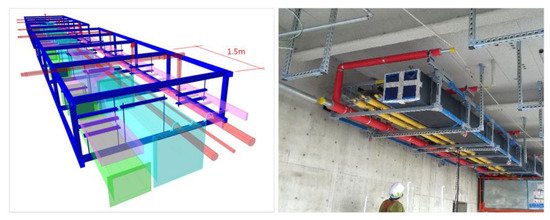The architecture, engineering, and construction (AEC) industry has seen significant transformation in recent years, with Building Information Modeling (BIM) emerging as a cornerstone for modern project execution.
Among its many applications, Mechanical, Electrical, and Plumbing (MEP) BIM services stand out for their ability to streamline complex design and construction processes.
Let’s delve into the latest trends shaping MEP BIM services, highlighting how innovation is driving advancements in the MEP industry.
Table of Contents
The Evolving Role of MEP BIM Services
MEP BIM services have transitioned from being optional aids to essential components in construction workflows. They ensure precise coordination between various disciplines, reduce errors and facilitate sustainable building practices. Here are the key factors contributing to their growing significance:
- Enhanced Collaboration: BIM fosters real-time collaboration among architects, engineers, and contractors, ensuring everyone is on the same page.
- Improved Accuracy: BIM’s 3D models provide a clearer visual representation, reducing ambiguities in design.
- Time and Cost Efficiency: Early detection of clashes and streamlined workflows lead to savings in both time and resources.
Top Trends in MEP BIM Services
1. Adoption of AI and Machine Learning in BIM
Artificial intelligence (AI) and machine learning are transforming the way MEP BIM services are executed. These technologies analyze vast amounts of data to predict outcomes, optimize designs, and even automate routine tasks.
- Predictive Maintenance: AI helps foresee potential system failures, enabling proactive maintenance.
- Automated Clash Detection: Machine learning algorithms improve clash detection and resolution processes, saving significant time.
- Design Optimization: AI-driven insights help refine MEP layouts for better performance and sustainability.
2. Cloud-Based Collaboration Tools
As projects become more global, the need for seamless collaboration has led to the rise of cloud-based BIM platforms. These tools allow stakeholders to access, edit, and share MEP models in real time, regardless of their location.
- Centralized Data Management: Cloud platforms ensure that all stakeholders work with the latest version of the model.
- Enhanced Accessibility: Team members can access models from any device, improving flexibility.
- Data Security: Advanced encryption ensures that sensitive project data remains secure.
3. Sustainable BIM Solutions
Sustainability is no longer a trend; it’s a necessity. MEP BIM services play a critical role in designing energy-efficient systems that align with green building standards.
- Energy Analysis Tools: BIM software now integrates energy analysis capabilities to optimize HVAC, lighting, and water systems.
- Material Selection: BIM aids in selecting eco-friendly materials by analyzing lifecycle impacts.
- Waste Reduction: Precise planning minimizes material waste during construction.
4. Integration of IoT with BIM
The Internet of Things (IoT) is revolutionizing how buildings are managed post-construction. Integrating IoT with BIM enhances operational efficiency and user comfort.
- Smart Building Systems: IoT sensors feed real-time data into BIM models for better building management.
- Performance Monitoring: Ongoing monitoring of MEP systems ensures optimal performance and quick issue resolution.
- Enhanced Maintenance: BIM-enabled IoT provides detailed insights, making maintenance more predictable and efficient.
5. Modern BIM Workflows with 4D and 5D BIM
Traditional 3D BIM models are now being augmented with 4D (time) and 5D (cost) dimensions, providing deeper insights into project timelines and budgets.
- 4D BIM: Enables detailed scheduling and sequencing, improving project planning.
- 5D BIM: Links cost data with the model, providing accurate budget forecasts.
- Visual Simulations: Stakeholders can visualize construction phases and financial implications before execution.
6. Increased Emphasis on Prefabrication and Modular Construction
BIM is driving the shift towards prefabrication and modular construction, which are becoming increasingly popular in the MEP industry.
- Precision in Design: BIM’s detailed models ensure accurate prefabrication of components.
- Reduced On-Site Work: Modular construction minimizes labor-intensive activities at the site.
- Faster Project Delivery: Prefabrication significantly shortens construction timelines.
7. Digital Twin Technology
Digital twins are virtual replicas of physical assets that provide real-time data for better decision-making. In MEP BIM services, digital twins are proving to be game changers.
- Lifecycle Management: Digital twins help manage buildings throughout their lifecycle.
- Operational Insights: Continuous data collection improves system efficiency and reduces downtime.
- Enhanced Retrofitting: Digital twins provide detailed models for effective renovations and upgrades.
8. Focus on Compliance and Standards
Regulatory compliance is becoming increasingly stringent, and BIM helps ensure that MEP designs meet all necessary standards.
- Code Compliance: BIM software checks design against local building codes and standards.
- Documentation: Automated reports make it easier to submit documents for approvals.
- Quality Assurance: BIM ensures that designs meet performance and safety criteria.
The Future of MEP BIM Services
As the construction industry embraces digital transformation, the role of MEP BIM services will continue to expand. Key areas of growth include:
- Advancements in Augmented Reality (AR): AR tools integrated with BIM will provide immersive design reviews and on-site guidance.
- Robotics in Construction: Robots guided by BIM models will perform tasks like installation and maintenance with unmatched precision.
- Zero-Carbon Buildings: MEP BIM will be at the forefront of designing systems for net-zero carbon emissions.
Why Embracing These Trends Matters
Staying ahead of these trends is crucial for MEP contractors, designers, and other stakeholders. Here’s why:
- Competitive Edge: Companies adopting modern BIM workflows are better positioned to win projects.
- Cost Savings: Digital tools and processes reduce waste, errors, and overall project costs.
- Enhanced Client Satisfaction: Delivering efficient, sustainable, and innovative solutions builds long-term client relationships.
Conclusion
The MEP industry is undergoing a profound transformation, with BIM services leading the charge. By embracing innovations such as AI, IoT, and digital twins, stakeholders can achieve unparalleled efficiency, sustainability, and precision in their projects. Staying updated with these trends isn’t just an option, it’s a necessity in today’s competitive landscape.
Whether you’re an MEP contractor or a designer, adopting these advancements will position your projects for success in an ever-evolving industry. The future of MEP BIM services is bright, and the journey toward smarter, greener, and more efficient buildings has only just begun.
Our skilled and scalable MEP BIM Team is here to help you harness the power of BIM to make your designs accurate, innovative and code compliant.






